|

from
SkyBooksUSA
Website
Time Machines
Super-Science, NOT Fantasy!
Science Fact: Scientists say building a time machine may be
extremely difficult. But time travel is not against the laws of
physics!
For thousands of years, scientists and philosophers have talked of
time as a river that flows steadily onward year after year. But what
if there were a way to swim against the flow, or to run down the
bank ahead of the river? Might we be able to journey back and forth
in time just as we travel through space? The idea is not as
far-fetched as it sounds, and the implications for the future are
intriguing.
Ever since Einstein, scientists have considered three-dimensional
space and time not as two different things, but as different aspects
of four-dimensional "space-time." Quantum physicists, who study the
world of subatomic particles, often find it easier to explain events
by assuming time runs backward as well as forward, however much it
defies common sense. At the other extreme, cosmologists looking at
the universe on a grand scale have found that space and time can be
warped by gravity and speed. Back in the 1940s, German mathematician
Kurt Goedel proved that if we could warp and twist space-time enough
– creating what he called "closed, timelike curves" – then we could
bore tunnels through time itself. But no one knew how to do the
twisting – until black holes. The gravitational pull of a black hole
is so enormous that it distorts the very fabric of space-time into
what is called a singularity. When singularities were found to spin,
it was proved that closed, timelike curves not only can occur – they
must occur. The singularity forms a doughnut shape in space-time,
while the hole in the middle is a perilous gateway to somewhere – or
when.
On the following pages we’ll show you some ways it may be possible
to travel in time without breaking the rules.
Time Machines in our Future!...
Interview with David Anderson, Ph.D.
August 3, 1999 in Frankfurt, Germany
Dr. David Anderson is the President and founder of a very unique
company called the Time Travel Research Center based in the United
States of America. His background is one of the world’s most
experienced in the field of space-time study and includes more than
twenty years of activity in the field of time control research.
GMD: Dr. Anderson, thank you for joining us.
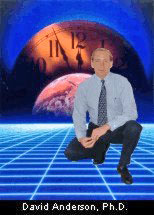 Anderson: You are quite welcome. I appreciate and thank you for the
opportunity to be here today. Anderson: You are quite welcome. I appreciate and thank you for the
opportunity to be here today.
GMD: Dr. Anderson, I have to say that your company is one of the
most interesting I have ever encountered. Can you tell us a little
about the Time Travel Research Center?
Anderson: Of course. The Time Travel Research Center is a
privately-owned research laboratory based on Long Island, New York
in the United States of America. The company was founded in 1995 and
is exclusively dedicated to the advancement of the science,
technology and research that will deliver practical time control and
someday time travel capabilities. I believe we are a leader in the
development of capabilities to pursue this goal and are the only
company of its kind dedicated exclusively to pursuing the
achievement of time control and time travel. We support private
research and development and also pioneered and manage the
development of the TRI-STAR Information System which is the worlds
largest knowledge base of science, technology, and research
applicable to the subject of time and time travel. The TRI-STAR
system’s simulation programs also represent one of the most advanced
space-time virtual laboratories in the world today, designed and
optimized specifically for research in this field of study. The
Center also founded and manages the Time Travel Research
Association, the largest time travel interest group in the world.
GMD: I have heard a lot about the Time Travel Research Association.
But before we discuss this could you tell us exactly how did you get
started? How does someone become interested and involved in time
control research and development?
Anderson: It initially began when I was very young. I suppose I had
developed a strong interest and ability in mathematics and physics
at an early age. After scoring very high on a government exam of
some type the United States Air Force began repeatedly trying to
recruit me to join the Air Force and participate in their advanced
research and development programs. This continued for a couple years
during high school and while I was finishing my undergraduate degree
program at West Virginia University. At the time I didn’t know that
I might be involved specifically in space-time research, but it was
a strong interest for me at this time. I finally accepted their
offer and then spent almost five years as a United States Air Force
Officer, Flight Test Engineer, and Scientist, conducting advanced
space-time research at the prestigious Air Force Flight Test Center
in the Mojave desert.
GMD: What did you do during your tenure at the Air Force Flight Test
Center?
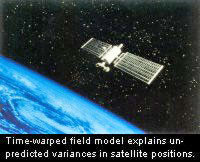 Anderson: I did many things... many things that I still cannot
discuss today. But I can say that the focus of my work was in the
research, development, test and evaluation of space-time models and
systems. It was here at the Air Force Flight Test Center that I
began building a detailed understanding and passion for space-time
physics. I moved from project to project developing new mathematical
methods and models to help advance space-time study, test and
evaluation. I remember that just as I was finishing my graduate
program with California State University that I became almost
completely obsessed in trying to solve a very specific and elusive
problem. The problem was to explain an unpredicted and unexplainable
variance in position that some of our space-based satellite systems
experienced over longer periods of time. I was finally successful in
solving the problem by creating a predictable and reliable
mathematical model. However, even though my model worked, it took
several more years for me to refine and really understand it. When I
finally did I couldn’t believe what I was looking at. Anderson: I did many things... many things that I still cannot
discuss today. But I can say that the focus of my work was in the
research, development, test and evaluation of space-time models and
systems. It was here at the Air Force Flight Test Center that I
began building a detailed understanding and passion for space-time
physics. I moved from project to project developing new mathematical
methods and models to help advance space-time study, test and
evaluation. I remember that just as I was finishing my graduate
program with California State University that I became almost
completely obsessed in trying to solve a very specific and elusive
problem. The problem was to explain an unpredicted and unexplainable
variance in position that some of our space-based satellite systems
experienced over longer periods of time. I was finally successful in
solving the problem by creating a predictable and reliable
mathematical model. However, even though my model worked, it took
several more years for me to refine and really understand it. When I
finally did I couldn’t believe what I was looking at.
GMD: What was it?
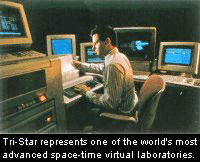 Anderson: It turned out to be an absolutely complete space-time
model. It included every aspect of relativistic physics even
including consideration for details like frame-dragging that is
caused by the gravity and spin of the Earth and the Moon. This
resolved the discrepancy in the satellite position almost perfectly.
What was most exciting wasn’t the existence of the mathematical
model itself, but the relationships that fell out of it. At this
point in time I began to develop what I labelled "Time-warped Field
Theory" to describe these relationships and how they could be
applied for practical time control applications. I left the United
States Air Force to continue my work and spent almost all of my time
since then working to fund my research, advance my theories, build
our TRI-STAR virtual laboratory, and plan the launch of the Time
Travel Research Center. Anderson: It turned out to be an absolutely complete space-time
model. It included every aspect of relativistic physics even
including consideration for details like frame-dragging that is
caused by the gravity and spin of the Earth and the Moon. This
resolved the discrepancy in the satellite position almost perfectly.
What was most exciting wasn’t the existence of the mathematical
model itself, but the relationships that fell out of it. At this
point in time I began to develop what I labelled "Time-warped Field
Theory" to describe these relationships and how they could be
applied for practical time control applications. I left the United
States Air Force to continue my work and spent almost all of my time
since then working to fund my research, advance my theories, build
our TRI-STAR virtual laboratory, and plan the launch of the Time
Travel Research Center.
GMD: So is the goal of your research is to produce a time machine?
Anderson: It does seem that anytime someone mentions space-time
physics this question arises almost within the same breath. Can we
build a time machine that we can step into that can teleport us
anywhere-anytime? Sometimes it seems that this is always considered
to be the "holy grail" of space-time physics. I won’t deny that some
of our research focuses in this direction. This will be realized, I
am sure of that. But I believe most of us will see the application
of time-warped field theory and time control in more practical
everyday applications first.
GMD: What kind of applications? I have heard something about your
ties to something called "Project Darkstar." Is this a military
weapons program and the application you are referring too?
Anderson: Well "Project Darkstar" is one of our projects... and I
suppose the name does sound a little sinister and brings to mind
weapons of mass destruction. However, Project Darkstar’s first
application will probably be in medical applications, but its not
limited to this field. Where did you hear about the project?
GMD: From two different places, one in Australia and another in the
United States. But that isn’t important. Can you tell us more about
the results you have produced and anything you can about project
Darkstar?
Anderson: Well Project Darkstar is one of our first projects to
apply time-warped field technology for practical application. So far
we have been successful in creating and demonstrating small
self-contained time-warped fields. The current field size we are
moving to now is about 10 to 12 centimeters in diameter. A
considerable amount of work will be required to increase the field
size from here but it is definitely achievable with more time and
funding. But the field size of 10 to 12 centimeters we are creating
now is more than enough for many short-term applications we are
already researching.
GMD: Wait, lets slow down. I don’t understand exactly what this
field is. What is it and how it can be used?
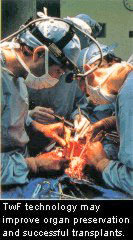 Anderson: It is a self-contained spherical time-warped field. Within
its boundaries we can actually accelerate or decelerate to a certain
degree the rate at which time passes relative to the rate of time
outside of the field. Perhaps the best way to describe it is to
discuss some of the applications of this technology. Lets go back to
the medical application. Anderson: It is a self-contained spherical time-warped field. Within
its boundaries we can actually accelerate or decelerate to a certain
degree the rate at which time passes relative to the rate of time
outside of the field. Perhaps the best way to describe it is to
discuss some of the applications of this technology. Lets go back to
the medical application.
We are currently researching several applications in the medical
field. One would be transplant organ preservation. The time-warped
field will be used to preserve organs or tissues awaiting
transplant. In this case the organ would be stored in a special
container within the time-warped field. Here it would be exposed to
a significant retardation in the rate of time passage that would
keep the organ healthy and fresh for a longer period of time. This
will greatly increase the success rate of transplant operations and
will also provide a solution for organs to be stored and made
available for longer periods of time... so they can be available
when they are really needed.
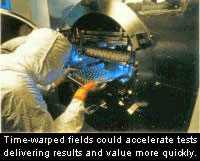 Another area of great interest and application of this technology is
for scientific test acceleration or retardation. Not only in the
medical field but in many others. In many disciplines the speed at
which research can be accomplished, or results can be produced, is
gated by the length of time required by certain natural processes or
chemical reactions. Utilizing the time-warped field technology we
will be able to actually accelerate this testing and research,
hopefully without compromising the quality of the results. This will
have tremendous advantages in many industries and research around
the world. The number of new avenues in research and development
this could open up are significant. Another area of great interest and application of this technology is
for scientific test acceleration or retardation. Not only in the
medical field but in many others. In many disciplines the speed at
which research can be accomplished, or results can be produced, is
gated by the length of time required by certain natural processes or
chemical reactions. Utilizing the time-warped field technology we
will be able to actually accelerate this testing and research,
hopefully without compromising the quality of the results. This will
have tremendous advantages in many industries and research around
the world. The number of new avenues in research and development
this could open up are significant.
GMD: So this is all theoretical, right?
Anderson: No, the technology is real.
GMD: Well, this sounds hard to believe, what actual results have you
produced to verify this?
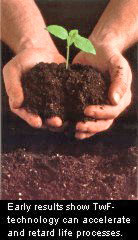 Anderson: Several. First, we have demonstrated time rate
acceleration and retardation using both mechanical and electronic
clocks. Placing one clock with the field and a reference clock
outside we can show the time rate divergence as the field is
"adjusted." We also recently demonstrated the effect on a living
organism successfully accelerating and retarding the germination and
growth of plant seedlings. We set up a control group outside of the
field and repeated several tests where a seedling was allowed to
germinate and grow within the field itself. Here we repeatedly and
consistently demonstrated control and actual time rate divergences
between the two test groups. Anderson: Several. First, we have demonstrated time rate
acceleration and retardation using both mechanical and electronic
clocks. Placing one clock with the field and a reference clock
outside we can show the time rate divergence as the field is
"adjusted." We also recently demonstrated the effect on a living
organism successfully accelerating and retarding the germination and
growth of plant seedlings. We set up a control group outside of the
field and repeated several tests where a seedling was allowed to
germinate and grow within the field itself. Here we repeatedly and
consistently demonstrated control and actual time rate divergences
between the two test groups.
GMD: Why plants? Why wouldn’t you... or have you tested this on
people or animals?
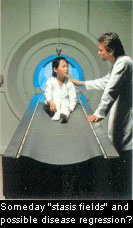 Anderson: No, testing this on animals or people is much too
dangerous at this time. First the field size is much too small. But
more importantly this would be very dangerous for the following
reason. Anderson: No, testing this on animals or people is much too
dangerous at this time. First the field size is much too small. But
more importantly this would be very dangerous for the following
reason.
The field boundaries have some very "unique" characteristics that
would be very dangerous if mis-applied at this time. This is why we
decided to focus on organ preservation and scientific test
acceleration first. But we don’t exclude the possibility and we even
anticipate that after much more development that we will be able to
create stasis fields and then eventually certain types of disease
regression capabilities in the future.
But given the dangers it is much better that we walk before we run
here.
GMD: It sounds like you have a lot of passion and interest for the
application of your T.w.F. Technology (Time-warped Field technology)
for medical and health care use?
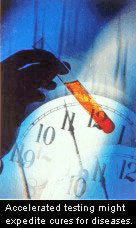 Anderson: Yes, I do. The impact this technology could have on
accelerating research and finding cures for diseases like heart
disease, cancer, diabetes and aids is profound. We do believe that
our TwF Technology will eventually permit certain types of actual
disease regression as our development continues and we find safer
ways to use it on a living person. But in the short-term the
benefits in accelerating and opening up new avenues of research will
have such a large positive impact that we feel it may entirely
change the way the world looks at and performs research and may help
us move more quickly to new cures or treatments for these diseases. Anderson: Yes, I do. The impact this technology could have on
accelerating research and finding cures for diseases like heart
disease, cancer, diabetes and aids is profound. We do believe that
our TwF Technology will eventually permit certain types of actual
disease regression as our development continues and we find safer
ways to use it on a living person. But in the short-term the
benefits in accelerating and opening up new avenues of research will
have such a large positive impact that we feel it may entirely
change the way the world looks at and performs research and may help
us move more quickly to new cures or treatments for these diseases.
GMD: It sounds like the benefit of this new technology could have a
tremendous influence on medical cure and treatment research.
Anderson: Yes, absolutely.
GMD: You mentioned earlier that
Project Darkstar wasn’t limited to
just medical applications. What other applications do you see for
this technology?
Anderson: Well the applications we just discussed as I mentioned are
short-term applications. As we continue to study and develop our
Time-warped Field technology we see other possible uses of the
technology emerging. One of the first is the development of
"containment fields."
GMD: Containment fields... What is this and how would it be used?
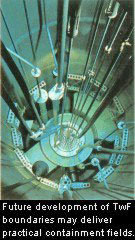 Anderson: As I mentioned earlier the boundaries of a Time-warped
Field have some very unique characteristics. Some of which are very
dangerous to living tissue. But some of these same characteristics
that make them dangerous may allow them to be used to contain
materials or energy that if exposed could cause damage if released.
I suppose I’m not explaining this well. Its usually easier to
discuss the technology and application with my presentation
materials. Anderson: As I mentioned earlier the boundaries of a Time-warped
Field have some very unique characteristics. Some of which are very
dangerous to living tissue. But some of these same characteristics
that make them dangerous may allow them to be used to contain
materials or energy that if exposed could cause damage if released.
I suppose I’m not explaining this well. Its usually easier to
discuss the technology and application with my presentation
materials.
But for example, we see T.w.F. technology possibly being used to
create a containment field that can be used with nuclear reactor
cores to prevent the escape of dangerous radiation which can be very
harmful or deadly to people, or any living creature nearby. Another
application would be to protect against the escape of hazardous
materials during handling, storage, or transport. There are many
materials and organisms that are very deadly if exposed to living
organisms and this could be another new application where this
technology could have a tremendous impact.
I have to stress that analysis of the
Time-warped Field boundaries
is difficult and we still have much to learn. Another of our
projects, "Project Prime-Zero", is dedicated totally to the analysis
of the boundary characteristics of the field. This is where our
Tri-Star simulator and virtual laboratory is key. So far the results
of simulations on the system have been very promising and have not
excluded that these types of containment fields may be possible with
further research and development. In fact, the results suggest
strongly that they are completely possible within the realm of the
mathematics and physics of T.w.F. theory.
GMD: It sounds like your computer simulators are critical to
projects like Prime-Zero and some of the others. Can you tell us a
little about this?
Anderson: Well, you are absolutely correct, our virtual laboratory
is key to analyzing and learning more about Time-warped field
technology and its application. Our simulation programs may
represent the most advanced space-time virtual laboratory in the
world. It is a system that has been designed and optimized
specifically and successfully for space-time research and
development. Hmm... I probably should control myself here because
this is a topic I like to talk too much about and we do not have
that much time. But we are very proud of our programs and they have
been invaluable to our research. I have personally invested now more
than fifteen years in the development of the Tri-Star system and
with that type of "investment" its easy to get carried away.
GMD: That’s okay, tell us more about it.
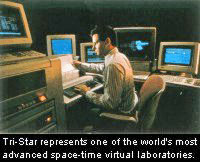 Anderson: Okay. As I mentioned the system can simulate a complete
and accurate space-time model for almost all of our research needs.
The Tri-Star system’s simulation programs were designed with one
goal in mind -- to advance our efforts to achieve time time control
and time-travel technology. It is a very unique scientific research
platform. Anderson: Okay. As I mentioned the system can simulate a complete
and accurate space-time model for almost all of our research needs.
The Tri-Star system’s simulation programs were designed with one
goal in mind -- to advance our efforts to achieve time time control
and time-travel technology. It is a very unique scientific research
platform.
The system is probably most unique in that it is very flexible and
quickly adaptable to the various types of T.w.F.
analysis and
testing we need to do. By bridging the walls between physics,
mathematics, and computation... and injecting our space-time
model... the Tri-Star system now delivers a powerful research and
development environment for us.
The system is used extensively before and after our hard experiments
to compare actual results v.s. computer predictions. More and more
though the greatest value has been in exploring and documenting the
nature and possible applications of time-warped field boundaries.
Overall I can’t express how valuable this program has been to our
success and progress across the board.
GMD: I would like to see the system someday. You mentioned that the
system addressed "almost all" of your research needs. Why "almost
all?" Can you explain?
Anderson: I did not realize I was that revealing. Yes, there are
some areas where we need to improve our simulation efficiency. The
nature and characteristics of the time-warped field boundaries as I
mentioned are very complex. I was probably understating this point.
The mathematical model of the field in this area is extremely
complex. Our Tri-Star simulation programs model the time-warped
field accurately but due to the complexity our analysis and research
in this area is progressing slower than we like, but it is
progressing.
GMD: Perhaps you should put your simulator inside the time-warped
field to accelerate your work.
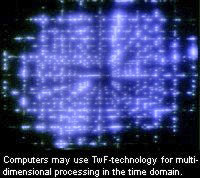 Anderson: Actually, we have seriously thought about it and are
looking at this as a possible long-term application of time-warped
field technology. We believe that when we increase the field-size
that we may be able to in fact do this. Anderson: Actually, we have seriously thought about it and are
looking at this as a possible long-term application of time-warped
field technology. We believe that when we increase the field-size
that we may be able to in fact do this.
There is much we still need to learn but it is quite possible that
T.w.F. technology will create new possibilities and avenues to
increase computer power and performance. Today we have parallel
processing... who knows, tomorrow we may have multi-dimensional
processing in an accelerated time domain. The technology may also
have some separate advantages in the computer manufacturing process
and it is very possible that T.w.F. technology will open some new
paths in super computer development and applications.
GMD: It seems like there are some exciting applications for use of
this technology today. And it seems that there are even more you are
trying to explore for the future. Are there any other applications
out there you have considered?
Anderson: Certainly, but we will have to wrap-up after this so I can
be sure to make my flight. If not... I will have a very long walk to
Bucuresti.
GMD: Okay.
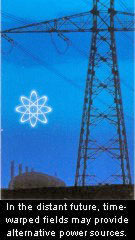 Anderson: Well, researching this particular application its not a
high priority effort, but as our Prime-Zero Project reveals more
about the nature and characteristics of the time-warped field
boundary we may find that the technology might provide a new source
of power. This power source efficiency could be extremely high
efficiency and would be a 100% environmentally clean technology.
Again, there are many unknowns and much research to do, but this is
a real possibility. Anderson: Well, researching this particular application its not a
high priority effort, but as our Prime-Zero Project reveals more
about the nature and characteristics of the time-warped field
boundary we may find that the technology might provide a new source
of power. This power source efficiency could be extremely high
efficiency and would be a 100% environmentally clean technology.
Again, there are many unknowns and much research to do, but this is
a real possibility.
GMD: Our understanding of time has certainly changed in recent
years, hasn’t it?
Anderson: The quest to understand time has been going on for
thousands of years. But yes, you are correct. The last hundred years
have revealed a lot. Time dilation and time control are achievable.
This is science-fact not science-fiction. Its easy in each of our
daily lives not to see this. But time control and even time travel
are no longer considered to be a pseudo-science... they are accepted
scientific, mathematical and physical fact. In fact, they are a
essential basic element and part of the fabric of the universe we
are living in right now. I suppose for many its just another example
of how science-fact can be stranger than science-fiction.
GMD: If someone is interested how can someone learn more about time
and time travel?
Anderson: I would first recommend visiting our web-site at
www.time-travel.com. The web-site present many views on the study of
time and time travel including views on physics, mathematics,
philosophy, metaphysics and even its implications and ties to
spirituality. We also publish a quarterly journal called The
Space-Time Journal that is packed with a lot of good and exciting
information on many subjects surrounding the study of time.
There are also many good books available on the subject. One of the
best I always recommend for someone just getting started is Paul J. Nahin’s "Time Machines." Also, "Space-time Physics" by
Edwin Taylor
and John Wheeler is a great introduction to a more mathematical view
of space-time physics. We also maintain a comprehensive index and
guide to hundreds of books and videos on the subject on our web-site
if someone needs more sources.
We also manage an association called the "Time Travel Research
Association." This is an association that networks time travel
information and interests from around the world. We currently have
more than 8,000 members from more than 78 countries. We sponsor the
association in an effort to try to help advance the study and
development of time control and time travel for anyone who is
interested. The Time Travel Research Association is a great way to
keep informed on news an updates and we even offer a free membership
option. Its a great way to study and learn. Another organization I
think many would find interesting is the "International Society for
the Study of Time." I believe they have a web-site at
www.studyoftime.org.
GMD: One last question. What should we look for coming from the
Time
Travel Research Center in the future?
Anderson: Well if our research continues to resolve itself as we’ve
planned... and we predict it will... we will all be seeing some
fascinating changes and the opening of an entire new industry based
on this technology. Time-warped Field (TwF)
technology, as we
continue to refine and enhance its application, will have a profound
impact on our world. The future will definitely be an exciting
"time."
GMD: Dr. Anderson, thank you for your... "time" today.
Anderson: Your quite welcome. Thank you.
Dr. David Anderson can be contacted by e-mail at
danderson@time-travel.com or by regular mail by writing to the Time
Travel Research Center, P.O. Box 1047, Smithtown, NY 11787-8547,
UNITED STATES OF AMERICA.
Time Machines
by John Gribbin
TIME TRAVEL has become, if not respectable, then certainly
fashionable in some quarters of the physics world over the past
decade or so. Much of the blame can be laid at the door of the
astronomer Carl Sagan, who was writing a science fiction novel in
the summer of 1985, and asked the relativist Kip Thorne, of
CalTech,
to come up with some plausible sounding scientific mumbo-jumbo to
"explain" the literary device of a wormhole through space which
could enable his characters to travel between the stars. Encouraged
to look at the equations of the general theory of relativity in a
new light, Thorne and his colleagues first found that there is
nothing in those equations to prevent the existence of such
wormholes, and then realized that any tunnel through space is also,
potentially, a tunnel through time. The laws of physics do not
forbid time travel.
This realization had two consequences. When Sagan’s novel, Contact,
appeared in 1986 it contained a passage that read like pure Sf
hokum, but which was (although few readers realized it at the time)
a serious science factual description of a spacetime wormhole. And
as Thorne and his colleagues began to publish scientific papers
about time machines and time travel, the spreading ripples have
stimulated a cottage industry of similar studies.
Curiously, this anecdote does not feature in Paul Nahin’s otherwise
remarkably comprehensive account of the fact and fiction of time
travel. Nahin is a professor of electrical engineering at the
University of New Hampshire, and the author of several published
science fiction stories, some dealing with the puzzles and paradoxes
of time travel. He tells us how he discovered, and "devoured"
science fiction stories at the age of ten, and this book is clearly
a labour of love. The approach is scholarly, with 36 pages of
footnotes, nine technical (but not overly mathematical) appendices,
and a no-holds-barred bibliography. Nahin’s style is distinctly more
sober than the material he deals with, but what he lacks in sparkle
he certainly makes up for in comprehensiveness.
The approach, in line with the author’s background, is from the
fiction and towards the fact. Old favourites, such as H. G. Wells
and Frank Tipler, make their expected appearances, as do less
familiar time travel fictions from the nineteenth century
(comfortably predating Albert Einstein’s theories) and more obscure
scientists and philosophers. And, of course, the familiar time
travel paradoxes get a thorough airing.
There are, though, two major weaknesses in Nahin’s treatment of the
science. The lesser is his discussion of black holes, which is weak
and sometimes a little confused. Much more importantly, though, he
fails to appreciate how the "many worlds" interpretation of quantum
mechanics allows a time traveller to go back in time and alter the
past without producing problems such as the notorious grandfather
paradox. In the conventional version of the paradox, a traveller
goes back and murders his grandfather as a young boy, so the
traveller could never have been born, so grandfather never died --
and so on. But in the many worlds version (championed today by David
Deutsch, of the University of Oxford), the act of killing grandad
creates a new reality, so that when the traveller then goes forward
in time he is no longer in his own world, but in the universe "next
door". This explains, for example, some of the more subtle touches
in the "Back to the Future" trilogy of movies, which Nahin comments
on while missing their point entirely. But although the book is
flawed, it is still welcome. It does not lend itself to being read
from front to back like a novel, but is ideal to dip in to and hop
around in, like a time traveller dipping in to history. It is also a
first class reference book for anyone interested in the Sf side of
time travel, and one that will be welcomed by the fans -- at least,
they will welcome it when and if it becomes available in paperback
at a sensible price.
Go Back
Worm Holes
 Since the 1930’s, physicists have speculated about the existence of
"wormholes" in the fabric of space. Wormholes are essentially
gateways between different parts of the universe and are made by
linking a pair of black holes. This effectively creates a tunnel
through time and space: A traveler entering at one end would exit
the other at a different time as well as a different place. The
difficulty lies in keeping the wormhole open while the traveler
makes his journey: If the opening snaps shut, he will never survive
to emerge at the other end. Since the 1930’s, physicists have speculated about the existence of
"wormholes" in the fabric of space. Wormholes are essentially
gateways between different parts of the universe and are made by
linking a pair of black holes. This effectively creates a tunnel
through time and space: A traveler entering at one end would exit
the other at a different time as well as a different place. The
difficulty lies in keeping the wormhole open while the traveler
makes his journey: If the opening snaps shut, he will never survive
to emerge at the other end.
For years, scientists believed that the transit was physically
impossible. But recent research, especially by the U.S. physicist
Kip Thorne, suggests that it could be done using exotic materials
capable of withstanding the immense forces involved. Even then, the
time machine would be of limited use – for example, you could not
return to a time before the wormhole was created. Using wormhole
technology would also require a society so technologically advanced
that it could master and exploit the energy within black holes. But
the trip would not be impossible – just very, very difficult!
Go Back
Worm Holes Engineering
There is still one problem with wormholes for any hyperspace
engineers to take careful account of. The simplest calculations
suggest that whatever may be going on in the universe outside, the
attempted passage of a spaceship through the hole ought to make the
star gate slam shut. The problem is that an accelerating object,
according to the general theory of relativity, generates those
ripples in the fabric of spacetime itself known as gravitational
waves. Gravitational radiation itself, travelling ahead of the
spaceship and into the black hole at the speed of light, could be
amplified to infinite energy as it approaches the singularity inside
the black hole, warping spacetime around itself and shutting the
door on the advancing spaceship. Even if a natural traversable
wormhole exists, it seems to be unstable to the slightest
perturbation, including the disturbance caused by any attempt to
pass through it.
But Thorne’s team found an answer to that for Sagan. After all, the
wormholes in Contact are definitely not natural, they are
engineered. One of his characters explains:
There is an interior tunnel in the exact Kerr solution of the
Einstein Field Equations, but it’s unstable. The slightest
perturbation would seal it off and convert the tunnel into a
physical singularity through which nothing can pass. I have tried to
imagine a superior civilization that would control the internal
structure of a collapsing star to keep the interior tunnel stable.
This is very difficult. The civilization would have to monitor and
stabilize the tunnel forever.
But the point is that the trick, although it may be very difficult,
is not impossible. It could operate by a process known as negative
feedback, in which any disturbance in the spacetime structure of the
wormhole creates another disturbance which cancels out the first
disturbance. This is the opposite of the familiar positive feedback
effect, which leads to a howl from loudspeakers if a microphone that
is plugged in to those speakers through an amplifier is placed in
front of them. In that case, the noise from the speakers goes into
the microphone, gets amplified, comes out of the speakers louder
than it was before, gets amplified . . . and so on. Imagine,
instead, that the noise coming out of the speakers and into the
microphone is analyzed by a computer that then produces a sound wave
with exactly the opposite characteristics from a second speaker. The
two waves would cancel out, producing total silence.
For simple sound waves, this trick can actually be carried out, here
on Earth, in the 1990s. Canceling out more complex noise, like the
roar of a football crowd, is not yet possible, but might very well
be in a few years time. So it may not be completely farfetched to
imagine Sagan’s "superior civilization" building a gravitational
wave receiver/transmitter system that sits in the throat of a
wormhole and can record the disturbances caused by the passage of
the spaceship through the wormhole, "playing back" a set of
gravitational waves that will exactly cancel out the disturbance,
before it can destroy the tunnel.
But where do the wormholes come from in the first place? The way
Morris, Yurtsever and Thorne set about the problem posed by
Sagan
was the opposite of the way everyone before them had thought about
black holes. Instead of considering some sort of known object in the
Universe, like a dead massive star, or a quasar, and trying to work
out what would happen to it, they started out by constructing the
mathematical description of a geometry that described a traversable
wormhole, and then used the equations of the general theory of
relativity to work out what kinds of matter and energy would be
associated with such a spacetime. What they found is almost (with
hindsight) common sense. Gravity, an attractive force pulling matter
together, tends to create singularities and to pinch off the throat
of a wormhole. The equations said that in order for an artificial
wormhole to be held open, its throat must be threaded by some form
of matter, or some form of field, that exerts negative pressure, and
has antigravity associated with it.
Now, you might think, remembering your school physics, that this
completely rules out the possibility of constructing traversable
wormholes. Negative pressure is not something we encounter in
everyday life (imagine blowing negative pressure stuff in to a
balloon and seeing the balloon deflate as a result). Surely exotic
matter cannot exist in the real Universe? But you may be wrong.
Making antigravity
The key to antigravity was found by a Dutch physicist, Hendrik
Casimir, as long ago as 1948. Casimir, who was born in The Hague in
1909, worked from 1942 onwards in the research laboratories of the
electrical giant Philips, and it was while working there that he
suggested what became known as the Casimir effect.
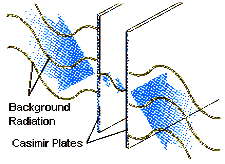 The simplest way to understand
the Casimir effect is in terms of two
parallel metal plates, placed very close together with nothing in
between them. The quantum vacuum is not like the kind of
"nothing" physicists imagined the vacuum to be before the quantum
era. It seethes with activity, with particle-antiparticle pairs
constantly being produced and annihilating one another. Among the
particles popping in and out of existence in the quantum vacuum
there will be many photons, the particles which carry the
electromagnetic force, some of which are the particles of light.
Indeed, it is particularly easy for the vacuum to produce virtual
photons, partly because a photon is its own antiparticle, and partly
because photons have no "rest mass" to worry about, so all the
energy that has to be borrowed from quantum uncertainty is the
energy of the wave associated with the particular photon. Photons
with different energies are associated with electromagnetic waves of
different wavelengths, with shorter wavelengths corresponding to
greater energy; so another way to think of this electromagnetic
aspect of the quantum vacuum is that empty space is filled with an
ephemeral sea of electromagnetic waves, with all wavelengths
represented. The simplest way to understand
the Casimir effect is in terms of two
parallel metal plates, placed very close together with nothing in
between them. The quantum vacuum is not like the kind of
"nothing" physicists imagined the vacuum to be before the quantum
era. It seethes with activity, with particle-antiparticle pairs
constantly being produced and annihilating one another. Among the
particles popping in and out of existence in the quantum vacuum
there will be many photons, the particles which carry the
electromagnetic force, some of which are the particles of light.
Indeed, it is particularly easy for the vacuum to produce virtual
photons, partly because a photon is its own antiparticle, and partly
because photons have no "rest mass" to worry about, so all the
energy that has to be borrowed from quantum uncertainty is the
energy of the wave associated with the particular photon. Photons
with different energies are associated with electromagnetic waves of
different wavelengths, with shorter wavelengths corresponding to
greater energy; so another way to think of this electromagnetic
aspect of the quantum vacuum is that empty space is filled with an
ephemeral sea of electromagnetic waves, with all wavelengths
represented.
This irreducible vacuum activity gives the vacuum an energy, but
this energy is the same everywhere, and so it cannot be detected or
used. Energy can only be used to do work, and thereby make its
presence known, if there is a difference in energy from one place to
another.
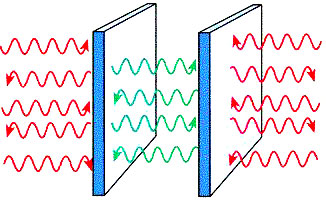 Between two electrically conducting plates,
Casimir pointed out,
electromagnetic waves would only be able to form certain stable
patterns. Waves bouncing around between the two plates would behave
like the waves on a plucked guitar string. Such a string can only
vibrate in certain ways, to make certain notes -- ones for which the
vibrations of the string fit the length of the string in such a way
that there are no vibrations at the fixed ends of the string. The
allowed vibrations are the fundamental note for a particular length
of string, and its harmonics, or overtones. In the same way, only
certain wavelengths of radiation can fit into the gap between the
two plates of a Casimir experiment. In particular, no
photon corresponding to a wavelength greater than the separation
between the plates can fit in to the gap. This means that some of
the activity of the vacuum is suppressed in the gap between the
plates, while the usual activity goes on outside. The result is that
in each cubic centimeter of space there are fewer virtual photons
bouncing around between the plates than there are outside, and so
the plates feel a force pushing them together. It may sound bizarre,
but it is real. Several experiments have been carried out to measure
the strength of the Casimir force between two plates, using both
flat and curved plates made of various kinds of material. The force
has been measured for a range of plate gaps from 1.4 nanometers to
15 nanometers (one nanometer is one billionth of a meter) and
exactly matches Casimir’s prediction. Between two electrically conducting plates,
Casimir pointed out,
electromagnetic waves would only be able to form certain stable
patterns. Waves bouncing around between the two plates would behave
like the waves on a plucked guitar string. Such a string can only
vibrate in certain ways, to make certain notes -- ones for which the
vibrations of the string fit the length of the string in such a way
that there are no vibrations at the fixed ends of the string. The
allowed vibrations are the fundamental note for a particular length
of string, and its harmonics, or overtones. In the same way, only
certain wavelengths of radiation can fit into the gap between the
two plates of a Casimir experiment. In particular, no
photon corresponding to a wavelength greater than the separation
between the plates can fit in to the gap. This means that some of
the activity of the vacuum is suppressed in the gap between the
plates, while the usual activity goes on outside. The result is that
in each cubic centimeter of space there are fewer virtual photons
bouncing around between the plates than there are outside, and so
the plates feel a force pushing them together. It may sound bizarre,
but it is real. Several experiments have been carried out to measure
the strength of the Casimir force between two plates, using both
flat and curved plates made of various kinds of material. The force
has been measured for a range of plate gaps from 1.4 nanometers to
15 nanometers (one nanometer is one billionth of a meter) and
exactly matches Casimir’s prediction.
In a paper they published in 1987, Morris and Thorne drew attention
to such possibilities, and also pointed out that even a
straightforward electric or magnetic field threading the wormhole
"is right on the borderline of being exotic; if its tension were
infinitesimally larger . . . it would satisfy our wormhole-building
needs." In the same paper, they concluded that "one should not
blithely assume the impossibility of the exotic material that is
required for the throat of a traversable wormhole." The two
CalTech
researchers make the important point that most physicists suffer a
failure of imagination when it comes to considering the equations
that describe matter and energy under conditions far more extreme
than those we encounter here on Earth. They highlight this by the
example of a course for beginners in general relativity, taught at
CalTech in the autumn of 1985, after the first phase of work
stimulated by Sagan’s enquiry, but before any of this was common
knowledge, even among relativists. The students involved were not
taught anything specific about wormholes, but they were taught to
explore the physical meaning of spacetime metrics. In their exam,
they were set a question which led them, step by step, through the
mathematical description of the metric corresponding to a wormhole.
"It was startling," said
Morris and Thorne, "to see how hidebound
were the students’ imaginations. Most could decipher detailed
properties of the metric, but very few actually recognized that it
represents a traversable wormhole connecting two different
universes."
For those with less hidebound imaginations, there are two remaining
problems -- to find a way to make a wormhole large enough for people
(and spaceships) to travel through, and to keep the exotic matter
out of contact with any such spacefarers. Any prospect of building
such a device is far beyond our present capabilities. But, as Morris
and Thorne stress, it is not impossible and "we correspondingly
cannot now rule out traversable wormholes." It seems to me that
there’s an analogy here that sets the work of such dreamers as Thorne and
Visser in a context that is both helpful and intriguing.
Almost exactly 500 years ago, Leonardo da Vinci speculated about the
possibility of flying machines. He designed both helicopters and
aircraft with wings, and modern aeronautical engineers say that
aircraft built to his designs probably could have flown if Leonardo
had had modern engines with which to power them -- even though there
was no way in which any engineer of his time could have constructed
a powered flying machine capable of carrying a human up into the
air. Leonardo could not even dream about the possibilities of jet
engines and routine passenger flights at supersonic speeds. Yet
Concorde and the jumbo jets operate on the same basic physical
principles as the flying machines he designed. In just half a
millennium, all his wildest dreams have not only come true, but been
surpassed. It might take even more than half a millennium for
designs for a traversable wormhole to leave the drawing board; but
the laws of physics say that it is possible -- and as Sagan
speculates, something like it may already have been done by a
civilization more advanced than our own.
Go Back
Cosmic Strings
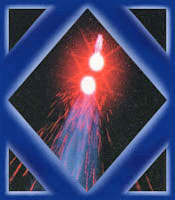 As a variation on the rotating cylinder, some scientists have
suggested using "cosmic strings" to construct a time machine. At the
moment, these are purely theoretical objects that might possibly be
left over from the creation of the universe in the Big Bang. A black
hole contains a one-dimensional singularity – an infinitely small
point in the space-time continuum. As a variation on the rotating cylinder, some scientists have
suggested using "cosmic strings" to construct a time machine. At the
moment, these are purely theoretical objects that might possibly be
left over from the creation of the universe in the Big Bang. A black
hole contains a one-dimensional singularity – an infinitely small
point in the space-time continuum.
A cosmic string, if such a thing existed, would be a two-dimensional
singularity – an infinitely thin line that has even stranger effects
on the fabric of space and time. Although no one has actually found
a cosmic string, astronomers have suggested that they may explain
strange effects seen in distant galaxies.
By maneuvering two cosmic strings close together – or possibly just
one string plus a black hole – it is theoretically possible to
create a whole array of "closed timelike curves." Your best bet is
to fire two infinitely long cosmic strings past each other at very
high speeds, then fly your ship around them in a carefully
calculated figure eight. In theory, you would be able to emerge
anywhere, anytime!
Go Back
Tipler Cilinders
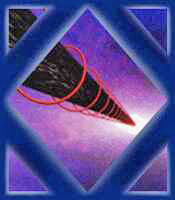 Civilizations with the technology to harness black holes might be
better advised to leave wormholes alone and try the time-warp method
suggested by U.S. astronomer Frank Tipler. He has a simple recipe
for a time machine: First take a piece of material 10 time the mass
of the Sun, squeeze it together and roll it into a long, thin,
super-dense cylinder – a bit like a black hole that has passed
through a spaghetti factory. Then spin the cylinder up to a few
billion revolutions per minute and see what happens. Civilizations with the technology to harness black holes might be
better advised to leave wormholes alone and try the time-warp method
suggested by U.S. astronomer Frank Tipler. He has a simple recipe
for a time machine: First take a piece of material 10 time the mass
of the Sun, squeeze it together and roll it into a long, thin,
super-dense cylinder – a bit like a black hole that has passed
through a spaghetti factory. Then spin the cylinder up to a few
billion revolutions per minute and see what happens.
Tipler predicts that a ship following a carefully plotted spiral
course around the cylinder would immediately find itself on a
"closed, timelike curve." It would emerge thousands, even billions,
of years from its starting point and possibly several galaxies away.
There are problems, though. For the mathematics to work properly,
Tipler’s cylinder has to be infinitely long. Also, odd things happen
near the ends and you need to steer well clear of them in your
timeship. However, if you make the device as long as you can, and
stick to paths close to the middle of the cylinder, you should
survive the trip!
Go Back
Paradoxes
What If Tourists From The Future Could Visit Us? If time machines
are possible, it is likely that someone in the future will already
have constructed one. After all, in the future there is time to
complete even the largest engineering project! Even if humans are
not up to the task, creatures from other planets may try.
So why are we not overrun by visitors from the future? This is the
argument used by the famous English physicist Stephen Hawking in
what he called his "chronology protection conjecture." Like many
other scientists, Hawking is troubled by the weird paradoxes of time
travel. He argues that the universe simply couldn’t allow time
travel to happen, because its evolution since the Big Bang cannot be
reversed. If the universe were to contract instead of expanding,
asks Hawking, would human beings "unevolve" in the same way they
have evolved over millions of years?
A second explanation for the absence of visitors from the future is
that none of the time machines envisaged so far lets the voyager go
back before the moment the machine was first constructed. So relax.
Since no one has built a time machine yet, out-of-time tourists are
not a problem!
Technical limitations aside, the "many worlds" theory also solves
most of the paradoxes of time travel. According to this theory, an
infinity of universes is constantly being created. In quantum
physics, when subatomic particles have a "choice" of options (such
as going through one hole or another in a screen), they select one
at random. The "many worlds" theory says that there is a universe
for each possible choice made by the particle.
"Many worlds" solves another of the famous time travel paradoxes.
Say you went back in time and shot your grandfather before he met
your grandmother. Would you never have been born? If not, you could
never have traveled back in time and shot your grandfather. Which
means that you "were" born, so you "could" have gone back… According
to "many worlds," when you go back in time you actually emerge in
another universe that develops in parallel to our own. But with an
infinity of universes to choose from, how can time travelers ever
hope to find their way back to the one they started out from?
Go Back
|
 Anderson: You are quite welcome. I appreciate and thank you for the
opportunity to be here today.
Anderson: You are quite welcome. I appreciate and thank you for the
opportunity to be here today. Anderson: I did many things... many things that I still cannot
discuss today. But I can say that the focus of my work was in the
research, development, test and evaluation of space-time models and
systems. It was here at the Air Force Flight Test Center that I
began building a detailed understanding and passion for space-time
physics. I moved from project to project developing new mathematical
methods and models to help advance space-time study, test and
evaluation. I remember that just as I was finishing my graduate
program with California State University that I became almost
completely obsessed in trying to solve a very specific and elusive
problem. The problem was to explain an unpredicted and unexplainable
variance in position that some of our space-based satellite systems
experienced over longer periods of time. I was finally successful in
solving the problem by creating a predictable and reliable
mathematical model. However, even though my model worked, it took
several more years for me to refine and really understand it. When I
finally did I couldn’t believe what I was looking at.
Anderson: I did many things... many things that I still cannot
discuss today. But I can say that the focus of my work was in the
research, development, test and evaluation of space-time models and
systems. It was here at the Air Force Flight Test Center that I
began building a detailed understanding and passion for space-time
physics. I moved from project to project developing new mathematical
methods and models to help advance space-time study, test and
evaluation. I remember that just as I was finishing my graduate
program with California State University that I became almost
completely obsessed in trying to solve a very specific and elusive
problem. The problem was to explain an unpredicted and unexplainable
variance in position that some of our space-based satellite systems
experienced over longer periods of time. I was finally successful in
solving the problem by creating a predictable and reliable
mathematical model. However, even though my model worked, it took
several more years for me to refine and really understand it. When I
finally did I couldn’t believe what I was looking at. Anderson: It turned out to be an absolutely complete space-time
model. It included every aspect of relativistic physics even
including consideration for details like frame-dragging that is
caused by the gravity and spin of the Earth and the Moon. This
resolved the discrepancy in the satellite position almost perfectly.
What was most exciting wasn’t the existence of the mathematical
model itself, but the relationships that fell out of it. At this
point in time I began to develop what I labelled "Time-warped Field
Theory" to describe these relationships and how they could be
applied for practical time control applications. I left the United
States Air Force to continue my work and spent almost all of my time
since then working to fund my research, advance my theories, build
our TRI-STAR virtual laboratory, and plan the launch of the Time
Travel Research Center.
Anderson: It turned out to be an absolutely complete space-time
model. It included every aspect of relativistic physics even
including consideration for details like frame-dragging that is
caused by the gravity and spin of the Earth and the Moon. This
resolved the discrepancy in the satellite position almost perfectly.
What was most exciting wasn’t the existence of the mathematical
model itself, but the relationships that fell out of it. At this
point in time I began to develop what I labelled "Time-warped Field
Theory" to describe these relationships and how they could be
applied for practical time control applications. I left the United
States Air Force to continue my work and spent almost all of my time
since then working to fund my research, advance my theories, build
our TRI-STAR virtual laboratory, and plan the launch of the Time
Travel Research Center. Anderson: It is a self-contained spherical time-warped field. Within
its boundaries we can actually accelerate or decelerate to a certain
degree the rate at which time passes relative to the rate of time
outside of the field. Perhaps the best way to describe it is to
discuss some of the applications of this technology. Lets go back to
the medical application.
Anderson: It is a self-contained spherical time-warped field. Within
its boundaries we can actually accelerate or decelerate to a certain
degree the rate at which time passes relative to the rate of time
outside of the field. Perhaps the best way to describe it is to
discuss some of the applications of this technology. Lets go back to
the medical application.  Another area of great interest and application of this technology is
for scientific test acceleration or retardation. Not only in the
medical field but in many others. In many disciplines the speed at
which research can be accomplished, or results can be produced, is
gated by the length of time required by certain natural processes or
chemical reactions. Utilizing the time-warped field technology we
will be able to actually accelerate this testing and research,
hopefully without compromising the quality of the results. This will
have tremendous advantages in many industries and research around
the world. The number of new avenues in research and development
this could open up are significant.
Another area of great interest and application of this technology is
for scientific test acceleration or retardation. Not only in the
medical field but in many others. In many disciplines the speed at
which research can be accomplished, or results can be produced, is
gated by the length of time required by certain natural processes or
chemical reactions. Utilizing the time-warped field technology we
will be able to actually accelerate this testing and research,
hopefully without compromising the quality of the results. This will
have tremendous advantages in many industries and research around
the world. The number of new avenues in research and development
this could open up are significant. Anderson: Several. First, we have demonstrated time rate
acceleration and retardation using both mechanical and electronic
clocks. Placing one clock with the field and a reference clock
outside we can show the time rate divergence as the field is
"adjusted." We also recently demonstrated the effect on a living
organism successfully accelerating and retarding the germination and
growth of plant seedlings. We set up a control group outside of the
field and repeated several tests where a seedling was allowed to
germinate and grow within the field itself. Here we repeatedly and
consistently demonstrated control and actual time rate divergences
between the two test groups.
Anderson: Several. First, we have demonstrated time rate
acceleration and retardation using both mechanical and electronic
clocks. Placing one clock with the field and a reference clock
outside we can show the time rate divergence as the field is
"adjusted." We also recently demonstrated the effect on a living
organism successfully accelerating and retarding the germination and
growth of plant seedlings. We set up a control group outside of the
field and repeated several tests where a seedling was allowed to
germinate and grow within the field itself. Here we repeatedly and
consistently demonstrated control and actual time rate divergences
between the two test groups. Anderson: No, testing this on animals or people is much too
dangerous at this time. First the field size is much too small. But
more importantly this would be very dangerous for the following
reason.
Anderson: No, testing this on animals or people is much too
dangerous at this time. First the field size is much too small. But
more importantly this would be very dangerous for the following
reason.  Anderson: Yes, I do. The impact this technology could have on
accelerating research and finding cures for diseases like heart
disease, cancer, diabetes and aids is profound. We do believe that
our TwF Technology will eventually permit certain types of actual
disease regression as our development continues and we find safer
ways to use it on a living person. But in the short-term the
benefits in accelerating and opening up new avenues of research will
have such a large positive impact that we feel it may entirely
change the way the world looks at and performs research and may help
us move more quickly to new cures or treatments for these diseases.
Anderson: Yes, I do. The impact this technology could have on
accelerating research and finding cures for diseases like heart
disease, cancer, diabetes and aids is profound. We do believe that
our TwF Technology will eventually permit certain types of actual
disease regression as our development continues and we find safer
ways to use it on a living person. But in the short-term the
benefits in accelerating and opening up new avenues of research will
have such a large positive impact that we feel it may entirely
change the way the world looks at and performs research and may help
us move more quickly to new cures or treatments for these diseases. Anderson: As I mentioned earlier the boundaries of a Time-warped
Field have some very unique characteristics. Some of which are very
dangerous to living tissue. But some of these same characteristics
that make them dangerous may allow them to be used to contain
materials or energy that if exposed could cause damage if released.
I suppose I’m not explaining this well. Its usually easier to
discuss the technology and application with my presentation
materials.
Anderson: As I mentioned earlier the boundaries of a Time-warped
Field have some very unique characteristics. Some of which are very
dangerous to living tissue. But some of these same characteristics
that make them dangerous may allow them to be used to contain
materials or energy that if exposed could cause damage if released.
I suppose I’m not explaining this well. Its usually easier to
discuss the technology and application with my presentation
materials.  Anderson: Okay. As I mentioned the system can simulate a complete
and accurate space-time model for almost all of our research needs.
The Tri-Star system’s simulation programs were designed with one
goal in mind -- to advance our efforts to achieve time time control
and time-travel technology. It is a very unique scientific research
platform.
Anderson: Okay. As I mentioned the system can simulate a complete
and accurate space-time model for almost all of our research needs.
The Tri-Star system’s simulation programs were designed with one
goal in mind -- to advance our efforts to achieve time time control
and time-travel technology. It is a very unique scientific research
platform.  Anderson: Actually, we have seriously thought about it and are
looking at this as a possible long-term application of time-warped
field technology. We believe that when we increase the field-size
that we may be able to in fact do this.
Anderson: Actually, we have seriously thought about it and are
looking at this as a possible long-term application of time-warped
field technology. We believe that when we increase the field-size
that we may be able to in fact do this.  Anderson: Well, researching this particular application its not a
high priority effort, but as our Prime-Zero Project reveals more
about the nature and characteristics of the time-warped field
boundary we may find that the technology might provide a new source
of power. This power source efficiency could be extremely high
efficiency and would be a 100% environmentally clean technology.
Again, there are many unknowns and much research to do, but this is
a real possibility.
Anderson: Well, researching this particular application its not a
high priority effort, but as our Prime-Zero Project reveals more
about the nature and characteristics of the time-warped field
boundary we may find that the technology might provide a new source
of power. This power source efficiency could be extremely high
efficiency and would be a 100% environmentally clean technology.
Again, there are many unknowns and much research to do, but this is
a real possibility.  Since the 1930’s, physicists have speculated about the existence of
"wormholes" in the fabric of space. Wormholes are essentially
gateways between different parts of the universe and are made by
linking a pair of black holes. This effectively creates a tunnel
through time and space: A traveler entering at one end would exit
the other at a different time as well as a different place. The
difficulty lies in keeping the wormhole open while the traveler
makes his journey: If the opening snaps shut, he will never survive
to emerge at the other end.
Since the 1930’s, physicists have speculated about the existence of
"wormholes" in the fabric of space. Wormholes are essentially
gateways between different parts of the universe and are made by
linking a pair of black holes. This effectively creates a tunnel
through time and space: A traveler entering at one end would exit
the other at a different time as well as a different place. The
difficulty lies in keeping the wormhole open while the traveler
makes his journey: If the opening snaps shut, he will never survive
to emerge at the other end.  The simplest way to understand
the Casimir effect is in terms of two
parallel metal plates, placed very close together with nothing in
between them. The quantum vacuum is not like the kind of
"nothing" physicists imagined the vacuum to be before the quantum
era. It seethes with activity, with particle-antiparticle pairs
constantly being produced and annihilating one another. Among the
particles popping in and out of existence in the quantum vacuum
there will be many photons, the particles which carry the
electromagnetic force, some of which are the particles of light.
Indeed, it is particularly easy for the vacuum to produce virtual
photons, partly because a photon is its own antiparticle, and partly
because photons have no "rest mass" to worry about, so all the
energy that has to be borrowed from quantum uncertainty is the
energy of the wave associated with the particular photon. Photons
with different energies are associated with electromagnetic waves of
different wavelengths, with shorter wavelengths corresponding to
greater energy; so another way to think of this electromagnetic
aspect of the quantum vacuum is that empty space is filled with an
ephemeral sea of electromagnetic waves, with all wavelengths
represented.
The simplest way to understand
the Casimir effect is in terms of two
parallel metal plates, placed very close together with nothing in
between them. The quantum vacuum is not like the kind of
"nothing" physicists imagined the vacuum to be before the quantum
era. It seethes with activity, with particle-antiparticle pairs
constantly being produced and annihilating one another. Among the
particles popping in and out of existence in the quantum vacuum
there will be many photons, the particles which carry the
electromagnetic force, some of which are the particles of light.
Indeed, it is particularly easy for the vacuum to produce virtual
photons, partly because a photon is its own antiparticle, and partly
because photons have no "rest mass" to worry about, so all the
energy that has to be borrowed from quantum uncertainty is the
energy of the wave associated with the particular photon. Photons
with different energies are associated with electromagnetic waves of
different wavelengths, with shorter wavelengths corresponding to
greater energy; so another way to think of this electromagnetic
aspect of the quantum vacuum is that empty space is filled with an
ephemeral sea of electromagnetic waves, with all wavelengths
represented. Between two electrically conducting plates,
Casimir pointed out,
electromagnetic waves would only be able to form certain stable
patterns. Waves bouncing around between the two plates would behave
like the waves on a plucked guitar string. Such a string can only
vibrate in certain ways, to make certain notes -- ones for which the
vibrations of the string fit the length of the string in such a way
that there are no vibrations at the fixed ends of the string. The
allowed vibrations are the fundamental note for a particular length
of string, and its harmonics, or overtones. In the same way, only
certain wavelengths of radiation can fit into the gap between the
two plates of a Casimir experiment. In particular, no
photon corresponding to a wavelength greater than the separation
between the plates can fit in to the gap. This means that some of
the activity of the vacuum is suppressed in the gap between the
plates, while the usual activity goes on outside. The result is that
in each cubic centimeter of space there are fewer virtual photons
bouncing around between the plates than there are outside, and so
the plates feel a force pushing them together. It may sound bizarre,
but it is real. Several experiments have been carried out to measure
the strength of the Casimir force between two plates, using both
flat and curved plates made of various kinds of material. The force
has been measured for a range of plate gaps from 1.4 nanometers to
15 nanometers (one nanometer is one billionth of a meter) and
exactly matches Casimir’s prediction.
Between two electrically conducting plates,
Casimir pointed out,
electromagnetic waves would only be able to form certain stable
patterns. Waves bouncing around between the two plates would behave
like the waves on a plucked guitar string. Such a string can only
vibrate in certain ways, to make certain notes -- ones for which the
vibrations of the string fit the length of the string in such a way
that there are no vibrations at the fixed ends of the string. The
allowed vibrations are the fundamental note for a particular length
of string, and its harmonics, or overtones. In the same way, only
certain wavelengths of radiation can fit into the gap between the
two plates of a Casimir experiment. In particular, no
photon corresponding to a wavelength greater than the separation
between the plates can fit in to the gap. This means that some of
the activity of the vacuum is suppressed in the gap between the
plates, while the usual activity goes on outside. The result is that
in each cubic centimeter of space there are fewer virtual photons
bouncing around between the plates than there are outside, and so
the plates feel a force pushing them together. It may sound bizarre,
but it is real. Several experiments have been carried out to measure
the strength of the Casimir force between two plates, using both
flat and curved plates made of various kinds of material. The force
has been measured for a range of plate gaps from 1.4 nanometers to
15 nanometers (one nanometer is one billionth of a meter) and
exactly matches Casimir’s prediction. As a variation on the rotating cylinder, some scientists have
suggested using "cosmic strings" to construct a time machine. At the
moment, these are purely theoretical objects that might possibly be
left over from the creation of the universe in the Big Bang. A black
hole contains a one-dimensional singularity – an infinitely small
point in the space-time continuum.
As a variation on the rotating cylinder, some scientists have
suggested using "cosmic strings" to construct a time machine. At the
moment, these are purely theoretical objects that might possibly be
left over from the creation of the universe in the Big Bang. A black
hole contains a one-dimensional singularity – an infinitely small
point in the space-time continuum.  Civilizations with the technology to harness black holes might be
better advised to leave wormholes alone and try the time-warp method
suggested by U.S. astronomer Frank Tipler. He has a simple recipe
for a time machine: First take a piece of material 10 time the mass
of the Sun, squeeze it together and roll it into a long, thin,
super-dense cylinder – a bit like a black hole that has passed
through a spaghetti factory. Then spin the cylinder up to a few
billion revolutions per minute and see what happens.
Civilizations with the technology to harness black holes might be
better advised to leave wormholes alone and try the time-warp method
suggested by U.S. astronomer Frank Tipler. He has a simple recipe
for a time machine: First take a piece of material 10 time the mass
of the Sun, squeeze it together and roll it into a long, thin,
super-dense cylinder – a bit like a black hole that has passed
through a spaghetti factory. Then spin the cylinder up to a few
billion revolutions per minute and see what happens.